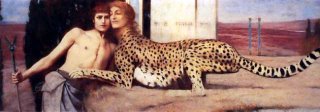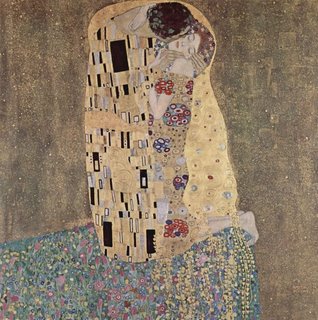 Sunday on the Hague (Lahey / Den Haag for those who don’t notice, all one city) brought together a good exhibition and a nice image of the city for the first time. The exhibition was one on the influence of Jan Toorop on Gustav Klimt, which I think is a very legitimate theme, yet, much less important than seeing Klimt’s work for the first time (for real). I appreciate the link between the two, but I found the psyche of the artists missing. To contrast their themes would surely be more interesting for me.
Sunday on the Hague (Lahey / Den Haag for those who don’t notice, all one city) brought together a good exhibition and a nice image of the city for the first time. The exhibition was one on the influence of Jan Toorop on Gustav Klimt, which I think is a very legitimate theme, yet, much less important than seeing Klimt’s work for the first time (for real). I appreciate the link between the two, but I found the psyche of the artists missing. To contrast their themes would surely be more interesting for me. Anyway, being no art critique I should stop here and return to my impressions and the info I could gather.
First, I should introduce Toorop (although I knew his paintings I didn’t know much about him till this exhibition).
He was born in Java, 1858, studied in Delft and Amsterdam and died in the Hague, 1928. His work merges Symbolism (particularly using Javanese motifs) and Art Nouveau (with elongated female figures and curvilinear designs) His “linear idealism” seems to have impressed Klimt. The link seems to stop there however, as Klimt changes shapes and forms into slogans and politics while Toorop regards art very personal.
Hague, 1928. His work merges Symbolism (particularly using Javanese motifs) and Art Nouveau (with elongated female figures and curvilinear designs) His “linear idealism” seems to have impressed Klimt. The link seems to stop there however, as Klimt changes shapes and forms into slogans and politics while Toorop regards art very personal.
What I found much more interesting was a painting by Klimt I’ve never seen before, which was marvellously Pre-Raphaelite. So were the works of other artists in the Vienna Circle, in which Toorop became famous. Most importantly the work of Fernand Khnopff, whose work you might remember is The Caress (also called The Sphinx). I would expect to have some relevance to Toorop’s obsession with the Sphinx, too. But the diversion is clear in the depictions, and hence I think Khnopff might have influenced Klimt at a different level: with his ability to express striking eroticism in a less than relevant subject matter. Khnopff (1858-1921) was a Belgian symbolist painter, who studied in l'academie des beaux art with Xavier Mellery, “who taught him to consider painting as an enquiry into the meaning hidden in the soul of things”. When he went to Paris one of his main inspirations was the Pre-Raphaelites (particularly Rossetti and Burne-Jones) and in his return he co-founded Groupe des XX.
Khnopff (1858-1921) was a Belgian symbolist painter, who studied in l'academie des beaux art with Xavier Mellery, “who taught him to consider painting as an enquiry into the meaning hidden in the soul of things”. When he went to Paris one of his main inspirations was the Pre-Raphaelites (particularly Rossetti and Burne-Jones) and in his return he co-founded Groupe des XX.
Hence the pre-Raphaelite link through the adherence to mimesis. (It seems that Khnopff was as interesting a figure as one of them as well… but not now…) His style “combines the visual precision of earlier Flemish artists of the 15th century, the modern realism of the Pre-Raphaelites.” Yet, he seems to have carried (and so did Toorop) the style of the Pre-Raphaelite Brotherhood into a higher level of abstraction and symbolism, whereby he excluded attention to detail and included ways of expressing much deeper enigmatic imagery and internal impulsions. He thought of his art as internal to himself ("One has only oneself" was his motto, and if I’m not wrong the title of one of his paintings), and was called the “painter of sentiments” and “the perfect symbolist”. His oeuvre contains significant affinities with Gustav Klimt, Edward Burne-Jones, and Gustave Moreau.
Khnopff was as interesting a figure as one of them as well… but not now…) His style “combines the visual precision of earlier Flemish artists of the 15th century, the modern realism of the Pre-Raphaelites.” Yet, he seems to have carried (and so did Toorop) the style of the Pre-Raphaelite Brotherhood into a higher level of abstraction and symbolism, whereby he excluded attention to detail and included ways of expressing much deeper enigmatic imagery and internal impulsions. He thought of his art as internal to himself ("One has only oneself" was his motto, and if I’m not wrong the title of one of his paintings), and was called the “painter of sentiments” and “the perfect symbolist”. His oeuvre contains significant affinities with Gustav Klimt, Edward Burne-Jones, and Gustave Moreau.
 One of his main themes was solitude and the image on the right titled as such reminds me terribly of the image created by Luc Besson in the movie The Messenger: The Story of Joan of Arc.
One of his main themes was solitude and the image on the right titled as such reminds me terribly of the image created by Luc Besson in the movie The Messenger: The Story of Joan of Arc.
The rest of my info on Khnopff come from this site.
“It's only as an artist, then, that we can know Khnopff. A stunningly accomplished draftsman over a range of media, he was masterful also in avoiding the two major pitfalls for artists of his time. The first was obsessive realism, dramatically illustrated by Khnopff's older contemporary, the Pre-Raphaelite artist William Holman Hunt, who once starved a goat and drenched it in whitewash after he discovered he could not find a thin-enough white goat to sit for his painting The Scapegoat. Rigid adherence to a narrowly conceived reality was the second danger. Gustave Courbet, a Realist from the generation prior to Khnopff's, famously declared that if someone would only show him an angel, he would gladly paint it. Khnopff and other Symbolist artists had no trouble painting angels (and in some cases "seeing" them).
Contrived symbolism and allegory can also be deadly for art, of course, but like his great Lowland predecessors, such as Jan Van Eyck, Hieronymus Bosch, and Pieter Brueghel, Khnopff had the ability to make his allegories seem fresh and affecting. This particular gift of imagination seems to have been remarkably common in that part of Europe both before and after Khnopff (Magritte was another practitioner), perhaps an effect of life in a historic crucible of religious tension and war.”


No comments:
Post a Comment